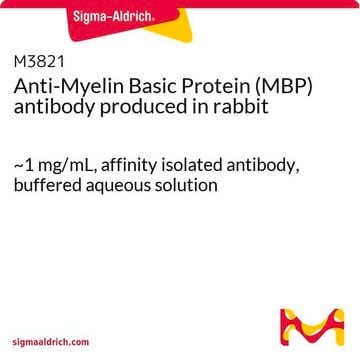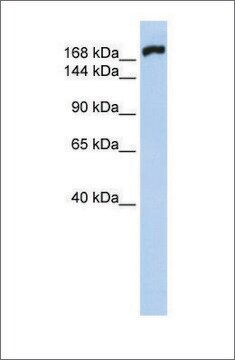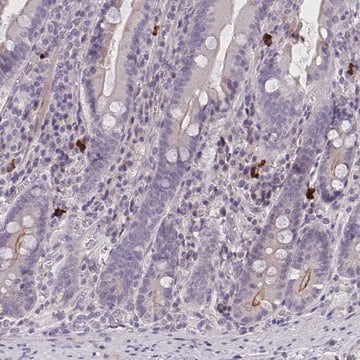AB1426
Anti-Uncoupling Protein 1 Antibody
Chemicon®, from rabbit
Synonym(s):
UCP1
Sign Into View Organizational & Contract Pricing
All Photos(1)
About This Item
UNSPSC Code:
12352203
eCl@ss:
32160702
NACRES:
NA.41
Recommended Products
biological source
rabbit
Quality Level
antibody form
purified immunoglobulin
antibody product type
primary antibodies
clone
polyclonal
species reactivity
human, rat, mouse
manufacturer/tradename
Chemicon®
technique(s)
ELISA: suitable
western blot: suitable
NCBI accession no.
UniProt accession no.
shipped in
dry ice
target post-translational modification
unmodified
Gene Information
human ... UCP1(7350)
Specificity
Reactive with mouse, rat, and human UCP1. Reactivity confirmed by western blot of purified UCP from brown adipose tissue. No cross-reactivity with UCP2.
Immunogen
Synthetic peptide corresponding to amino acids 145-159 of mouse UCP1. (C)SHLHGIKPRYTGTYN
Application
ELISA: 1:100,000
Western blot: 1:1,000
Optimal working dilutions must be determined by the end user.
Western blot: 1:1,000
Optimal working dilutions must be determined by the end user.
Research Category
Metabolism
Metabolism
Research Sub Category
Ion & Transport Channels
Ion & Transport Channels
This Anti-Uncoupling Protein 1 Antibody is validated for use in ELISA, WB for the detection of Uncoupling Protein 1.
Physical form
Format: Purified
Protein A-purified rabbit immunoglobulin. Liquid. Buffer = 100 mM KHPO4, 140 mM NaCl, pH 7. Contains no preservatives.
Storage and Stability
Maintain at -20 in undiluted aliquots for up to 12 months. Avoid repeated freeze/thaw cycles.
Legal Information
CHEMICON is a registered trademark of Merck KGaA, Darmstadt, Germany
Disclaimer
Unless otherwise stated in our catalog or other company documentation accompanying the product(s), our products are intended for research use only and are not to be used for any other purpose, which includes but is not limited to, unauthorized commercial uses, in vitro diagnostic uses, ex vivo or in vivo therapeutic uses or any type of consumption or application to humans or animals.
Not finding the right product?
Try our Product Selector Tool.
Storage Class Code
10 - Combustible liquids
WGK
WGK 2
Flash Point(F)
Not applicable
Flash Point(C)
Not applicable
Certificates of Analysis (COA)
Search for Certificates of Analysis (COA) by entering the products Lot/Batch Number. Lot and Batch Numbers can be found on a product’s label following the words ‘Lot’ or ‘Batch’.
Already Own This Product?
Find documentation for the products that you have recently purchased in the Document Library.
Kana Oue et al.
The Journal of biological chemistry, 291(8), 4185-4196 (2015-12-27)
Phospholipase C-related catalytically inactive protein (PRIP) was first identified as an inositol 1,4,5-trisphosphate-binding protein, and was later found to be involved in a variety of cellular events, particularly those related to protein phosphatases. We previously reported that Prip knock-out (KO)
Han Fang et al.
iScience, 24(5), 102470-102470 (2021-06-12)
Dietary methionine restriction (MR) is normally implemented using diets formulated from elemental amino acids (AA) that reduce methionine content to ∼0.17%. However, translational implementation of MR with elemental AA-based diets is intractable due to poor palatability. To solve this problem
Hongyi Zhou et al.
Journal of lipid research, 56(10), 1912-1925 (2015-08-14)
Mutations in BSCL2/SEIPIN cause Berardinelli-Seip congenital lipodystrophy type 2 (BSCL2), but the mechanisms whereby Bscl2 regulates adipose tissue function are unclear. Here, we generated adipose tissue (mature) Bscl2 knockout (Ad-mKO) mice, in which Bscl2 was specifically ablated in adipocytes of
Julio Sevillano et al.
Diabetologia, 62(1), 123-135 (2018-10-18)
Pleiotrophin, a developmentally regulated and highly conserved cytokine, exerts different functions including regulation of cell growth and survival. Here, we hypothesise that this cytokine can play a regulatory role in glucose and lipid homeostasis. To test this hypothesis, we performed
Hwan Hee Lee et al.
Nature communications, 10(1), 3536-3536 (2019-08-08)
Tonicity-responsive enhancer binding protein (TonEBP or NFAT5) is a regulator of cellular adaptation to hypertonicity, macrophage activation and T-cell development. Here we report that TonEBP is an epigenetic regulator of thermogenesis and obesity. In mouse subcutaneous adipocytes, TonEBP expression increases > 50-fold
Our team of scientists has experience in all areas of research including Life Science, Material Science, Chemical Synthesis, Chromatography, Analytical and many others.
Contact Technical Service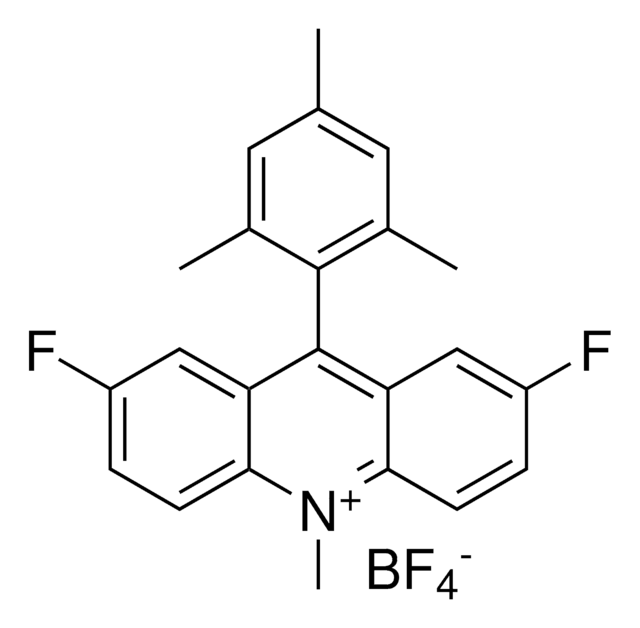


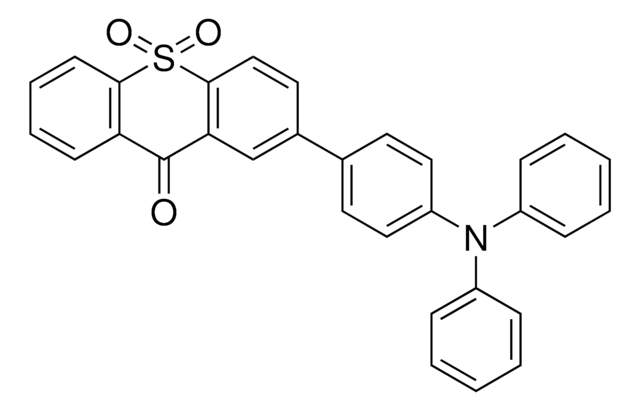


![Pr-DMQA[BF4] ≥95%](/deepweb/assets/sigmaaldrich/product/structures/125/737/e3893a03-436f-4514-a403-115bf49f2866/640/e3893a03-436f-4514-a403-115bf49f2866.png)
